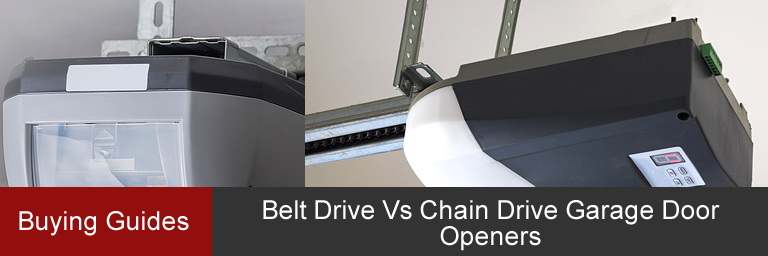
Affordable, noisy and strong, but subject to wear from metal-to-metal contact.
More expensive, with less lifting power, but good longevity with quieter operation.
You can probably guess that the first description is about a chain drive garage door opener while the second is about a belt drive opener.
This Chain Drive vs Belt Drive Garage Door Opener Guide provides the details including pros and cons and garage door opener cost.
Belt Drive versus Chain Drive Garage Door Opener
These two types of garage door openers are more alike than not when compared with types like jackshaft openers and sliding openers. And they make up more than 80% of all garage door openers.
After reading this page, you will have all of the information to make the best decision for your garage door opener installation or replacement project.
| Belt Drive vs Chain Drive Garage Door Opener | ||
| Chain Drive | Belt Drive | |
| Cost | Average $150 – $250 | Average $160 – $450 |
| Drive Type | Belt and pulleys | Chain and sprockets |
| Lifting Capacity | High | Moderate |
| Speed | Slower | Faster |
| Noise Level | Moderate | Low |
| Maintenance | Moderate | Low |
| WiFi Available | Yes | Yes |
| Slipping | No | Possible |
| Battery Backup | Yes – Less common | Yes – More common |
| Space Needed | Less | Slightly more |
What is a Chain Drive Garage Door Opener?
A chain drive opener uses a chain, similar to a bicycle chain, running inside a rail. The chain is connected to a trolley which holds a metal bar called a J-arm. The J-arm attaches to the garage door. As the trolley moves along the chain, the J- arm pulls the door up to open it or pushes the door down to close it.

A chain drive door opener is usually powered by an electric motor, although there are manual models available. In an electric model, the chain is fitted around the drive sprocket on the motor and the chain loops around an idler sprocket on the opposite end of the main rail. This completed circle of chain allows the motor to move the chain and trolley along the rail.
A chain drive garage door opener has a cord that can be used to open and close the door in the event of a power outage or used in manual models.
Chain Drive Advantages
Chain drive garage door openers are the most common and affordable openers available. Their advantages include their high tensile strength, meaning that the chain is very unlikely to stretch or break and provides greater lifting capacity than belt driven openers. Chain driven openers are the best choice for very heavy garage doors such as insulated doors, solid wood doors and oversized garage doors.
Chain drive garage door openers are also a good choice in very hot, humid, or wet climates where moisture can cause belt driven openers to slip.
With proper maintenance, a chain drive opener can outlast a belt drive opener under certain conditions, especially climates with extreme heat that causes belts to wear more quickly.
Chain Drive Disadvantages
Noise is the greatest disadvantage of chain drive garage door openers. They can vibrate and cause noise when in use because they involve gears and metal to metal contact. Chain drive openers may not be the best choice where the garage is located in a garage adjoining or below a bedroom.
Pro tip: When you want a chain drive model that will save you money, choose one with a DC motor and soft start-and-stop technology. Several brands use versions of the technology. These units are quieter than standard models.
Maintenance
Maintaining a chain drive garage door opener is fairly straightforward and is normally only needed twice each year. You will need to lubricate the chain with WD-40 or machine oil, take up any slack in the chain by turning the limit screw on the power unit, and tighten any loose hardware. If you want to make sure maintenance is properly done, contact the installer to price a “tune-up.” Cost, if no repairs are made, is $75 to $125 for most contractors.
What is a Belt Drive Garage Door Opener?
A belt drive garage door opener works in much the same way as a chain drive opener but, instead of a chain, a belt is used to move the trolley.

A fiberglass, polyurethane, or steel reinforced rubber belt with small gripping teeth runs along a track or rail. The belt holds a trolley which is connected to a bar called a J-arm or curved door arm. The J-arm is attached to the garage door. As the belt moves the trolley, the J- arm pulls the door up to open it or pushes the door down to close it.
Belt drive openers also have a sprocket located on the top of the motor that the belt wraps around. The belt ends are joined at the trolley with a threaded clip that can be adjusted to maintain belt tightness.
A belt drive garage door opener is powered by an electric motor, but they all have a release cord that allows you to open or close the garage door if the power goes out.
Belt Drive Advantages
Because they do not have any metal-on-metal parts causing vibrations, belt drive garage door openers are the quietest available. Belt drive openers also run smoother and faster while opening and closing the door.
Belt Drive Disadvantages
Belt drive garage openers are generally more expensive than chain drive models. Other disadvantages include the fact that high heat and humidity can cause the belt in these models to slip and malfunction or become brittle, reducing longevity. Belt drive garage door openers are able to open most garage doors but may not be suitable for steel doors, solid wood doors, or oversized doors. Raynor, a major manufacturer of garage door openers, says it recommends belt drive openers “for all except the heaviest doors such as composite overlay or all-wood doors.” That’s a fair statement for belt drive garage door openers from all top brands. Avoid using them with heavy garage door types.
Maintenance
Belt drive garage door openers require almost no maintenance and don’t need to be lubricated. If the belt becomes lose and droops, you can tighten the belt by rotating the screw on the spring clockwise. These are located on the trolley.
Features
Feature options are about the same. You can find both chain drive and belt drive openers with many useful features including battery back-up, built-in WiFi and Smart technology, keychain remotes, keypads, security codes, security lights, and even video cameras to record or live-stream what happens in your garage.
Garage Door Opener Motors

Whether chain drive or belt drive, all electric garage door openers come with a motor. There are two types of motors, AC and DC power. AC motors are larger, louder, and heavier than DC motors. DC motors have become the standard in the industry.
DC motors also allow for more features on the opener like soft start and battery back-up.
Did You Know That Your Garage Door Opener Doesn’t Do Much of the Lifting?
With both chain drive and belt drive openers, the garage door springs do the bulk of the work. As these springs wind and unwind, they provide energy that helps lift the door.
Horsepower
Garage door openers are available with ½ to 2 horsepower motors. Your choice will depend on the weight of your door. A ½ HP motor can handle most non-insulated 1 and 2 car, standard size doors. If you have an oversized solid wood door you will need a 1 to 2 HP motor.
Slightly upsizing the horsepower will allow the door to open and close faster and will put less wear and tear on the motor.
Garage door openers with DC motors may use power ratings as horsepower similar (HPS) or horsepower comparable (HPC) to assist in understanding their power capabilities.
Which is Better
Of course, it depends on what you’re looking for.
Choose chain drive if you want and affordable and tough garage door opener for a large or heavy garage door. They won’t slip in humid climates.
Choose a belt drive garage door opener is you prefer quiet operation, even if it costs a little more. They’re a good choice if your garage door is light to moderate in weight.








